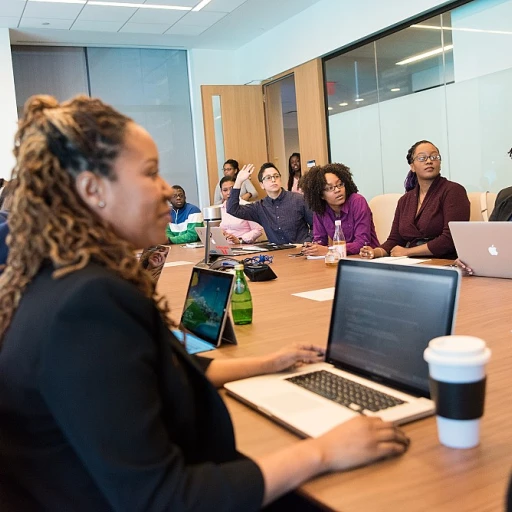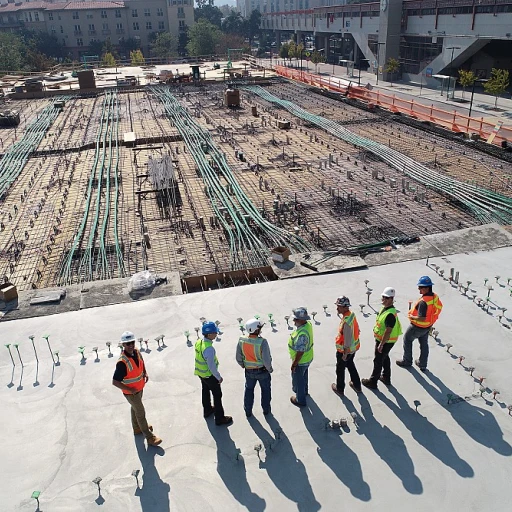
Understanding the Role of a CHRO in Organisational Transformation
Defining the Role of a CHRO in Transformation
The Chief Human Resources Officer (CHRO) plays a pivotal role in steering organizational transformation. As companies navigate the complexities of change, the CHRO is tasked with aligning human resources strategies with the broader business objectives. This involves not only managing the workforce but also fostering a culture that embraces change and innovation.
Leadership and Strategic Vision
At the heart of successful transformations is effective leadership. The CHRO must exhibit strong leadership skills to guide the organization through the transformation process. This includes setting a strategic vision that aligns with the company’s long-term goals and ensuring that all employees understand and are committed to this vision. By doing so, the CHRO helps create a unified direction that supports organizational change.
Building a Change-Ready Culture
One of the critical responsibilities of a CHRO is to cultivate an organizational culture that is adaptable and open to change. This involves promoting a mindset that values continuous improvement and innovation. A change-ready culture not only enhances the success rate of transformation initiatives but also ensures that the organization remains competitive in a rapidly evolving business environment.
Facilitating Effective Communication
Communication is a cornerstone of any successful transformation. The CHRO must ensure that there is clear and consistent communication throughout the organization. This involves keeping employees informed about the changes, the reasons behind them, and how they will impact the organization and its people. Effective communication helps to mitigate resistance and fosters a sense of ownership among employees.
For more insights on how HR leadership can embrace transformation and drive positive change, you can explore this path to positive change in HR leadership.
Key Challenges in Driving Organisational Change
Overcoming Common Obstacles in Transformational Leadership
The role of a Chief Human Resources Officer (CHRO) in steering a company through organizational changes encompasses a unique set of challenges that are crucial to the success of the transformation process. Effective change management requires a deep understanding of organizational culture, employee dynamics, and strategic leadership. A significant hurdle in initiating organizational change is resistance from employees. This resistance can stem from fear of the unknown, potential job security threats, or disruptions in established workflows and company culture. To overcome these challenges, CHROs should prioritize clear and continuous communication, ensuring that all employees are well informed about the transformation initiatives and their impact on both individuals and the broader business. Another challenge is aligning leadership with the transformational vision. For a successful transformation, it is vital to obtain buy-in from all leadership levels within an organization. CHROs must work closely with other leaders to ensure a unified direction and demonstrate the potential benefits of change. Decision-making can also pose a challenge during organizational transformations. Leaders may face pressure to make quick decisions while balancing long-term goals with immediate business needs. CHROs need to foster a decision-making environment that encourages discussion and utilizes data-driven insights to enhance the process. Incorporating a strategic approach to dealing with these challenges can significantly impact the success rate of organizational transformations. Those seeking deeper insights into becoming effective change management consultants can explore further resources on navigating the path to becoming a change management consultant. By addressing these challenges head-on, CHROs can better guide their companies through successful transformations.Strategies for Successful Transformation
Strategizing for Seamless Organizational Shifts
In order to successfully navigate the choppy waters of organizational transformation, chief human resources officers need to be armed with a meticulous strategy that encompasses several crucial facets. The role involves not only spearheading the change initiatives but also ensuring the orchestration of diverse elements to harmonize the transitional phases. A few methodologies stand out in enabling these transformations to be effective and sustainable.Building a Strong Leadership Coalition
A pivotal aspect lies in rallying a versatile team of leaders from different sectors of the company who are committed to change. This coalition serves as the engine driving the transformation process forward, engaging various organizational tiers to keep everyone aligned with the overarching goals. By instilling a shared vision for the future, leaders can foster a sense of ownership and accountability across the company, promoting a collaborative environment.Implementing a Comprehensive Communication Plan
Effective communication stands as a cornerstone of every successful transformation initiative. Stakeholders must be able to grasp the profound purpose and benefits of the transformation. Transparent communication ensures that employees feel informed, valued, and ready to embrace transformation success. Channels for dialogue should be established, allowing feedback and addressing concerns to cultivate a positive organizational culture.Aligning Change with Organizational Objectives
For transformation to be genuinely impactful, it must resonate with the company's business goals and growth strategies. The alignment between change initiatives and the company’s long-term vision is key to achieving a robust integration into daily business operations. Teams should regularly revisit these objectives to remain focused on the desired outcomes and avoid veering off course.Emphasizing Cultural Transformation
Culture and transformation are inextricably linked, and it is the responsibility of a CHRO to ensure that organizational change is consistent with the company's core values and culture. To this end, nurturing an adaptive and aligned organizational culture can lead to a higher success rate in transformation efforts. By emphasizing cultural alignment, businesses can ensure their employees' engagement and commitment towards the transformation goals. For further insights on enhancing business growth through digital strategies, click here to explore key approaches for digital transformation. These strategies, when effectively employed, can bolster the organization’s resilience and adaptability, leading to enduring success in its transformation journey.The Importance of Cultural Alignment
Aligning Company Culture with Transformation Efforts
The role of cultural alignment in organizational transformations cannot be overstated. A chief human resources officer plays a vital part in ensuring that the company's culture is not only preserved but also enhanced during periods of change. The intricacies of cultural adjustment demand a nuanced approach, as it's essential for the culture to evolve organically alongside business transformations. An effective transformation requires an alignment between organizational culture and the envisioned changes. This alignment facilitates smoother employee transitions and fosters receptiveness to new processes. Organizations that ignore the cultural aspect of change management often find themselves struggling with lower success rates in their transformation initiatives. To build a culture that supports successful transformations, CHROs must:- Assess Current Cultural Strengths and Weaknesses: Understanding existing cultural dynamics helps identify areas that align with or resist the planned changes.
- Foster Open Communication: Structured communication channels promote transparency and mitigate resistance among employees.
- Engage Leadership in Cultural Initiatives: Leaders play a crucial role in embodying and reinforcing the desired cultural attributes, making their engagement critical.
- Develop Cultural Training Programs: These programs are essential for educating employees on the new cultural expectations and behaviors.
Leveraging Technology in HR Transformation
Utilizing Technological Tools for HR Progress
In today's fast-paced business environment, technology plays a critical role in transforming human resources functions. To drive organizational change effectively, Chief Human Resources Officers (CHROs) must harness technology's potential to streamline processes, enhance communication, and foster a forward-thinking culture. By integrating sophisticated tools into HR practices, companies can experience increased efficiency and a higher success rate in their transformation initiatives. Several technologies can be particularly beneficial in supporting HR transformations:- HR Information Systems (HRIS): A robust HRIS can vastly improve the way organizations manage employee data and process information. By centralizing data, these systems enable more efficient handling of routine HR tasks, freeing up time for strategic decision-making.
- Talent Management Platforms: These platforms offer valuable insights into employee performance, learning, and development needs. Leveraging such tools facilitates better talent management, ensuring that the right people are in place to support ongoing change.
- Communication and Collaboration Tools: Facilitating open communication is vital during any transformation process. Tools that support collaboration and remote work can boost employee engagement and ensure that all stakeholders remain aligned with organizational objectives.
- Data Analytics: Advanced analytics enable CHROs to make informed decisions, understanding workforce dynamics and predicting future trends. This data-driven approach helps organizations adapt and thrive in a constantly changing environment.
- Artificial Intelligence (AI) and Machine Learning (ML): AI and ML technologies can automate repetitive tasks, enhance recruitment processes, and provide predictive analytics. These tools empower leaders to make more effective decisions, enhancing organizational development.
Measuring Success and Continuous Improvement
Evaluating Achievements and Encouraging Ongoing Enhancement
Ensuring the success of organizational transformation relies heavily on the ability to effectively measure its outcomes. Chief Human Resources Officers must implement a robust framework for evaluating the impact of change initiatives on both a short-term and long-term basis. This involves aligning transformation metrics with the company's strategic goals, and refining processes where necessary to bolster the success rate of these transformations.
- Defining Success Metrics: Establish clear, quantifiable success metrics that reflect the transformation objectives. These might include changes in employee engagement scores, productivity levels, or financial performance.
- Regular Monitoring: Conduct regular assessments and adjustments as part of an ongoing feedback loop. This ensures continuous alignment between transformation initiatives and organizational goals, enabling leaders to make informed decisions.
- Adapting to Change: Stay agile and ready to adapt strategies as the organization's needs evolve. Transformations are not a one-time event but a continuous journey demanding flexibility and responsiveness.
Incorporating feedback from employees is crucial in refining transformation strategies. As transformation affects all levels of the organization, input from various stakeholders provides valuable insights that can lead to more effective change management.
Moreover, nurturing a culture that supports risk-taking and innovation can facilitate the long-term success of transformation efforts. Encouraging an environment of continuous improvement not only enhances performance but also fosters a resilient organizational culture that is better equipped for future challenges.












